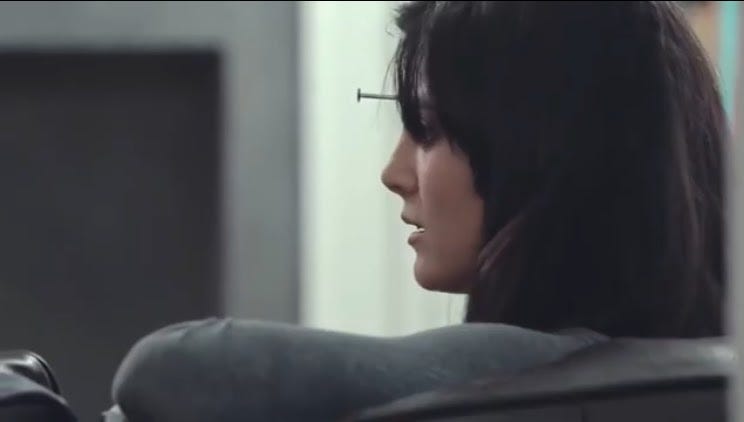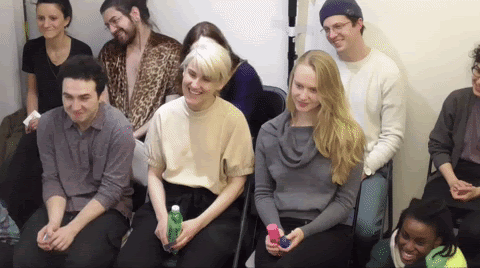Where does one go when in laughter ? Where does the mind go
plunged
into process?
There are always many answers. And now we attempt looking for a few.
Dulce is in front of her screen going with the flow as she mostly does. She is searching for specks of past things in the present, hours held, images latent with many meanings, all those things. She proceeds to show me Rollercoaster (2021) a video work running for more than ten minutes.
First frame is a dark screen. Thereafter a voice sounds out. About “all these pressure,” closing in on the cranium. Will it ever stop ?
Wont to do as a viewer, I expect answers. Instead there is a nail on a person’s forehead. I burst into laughter. The video proceeds with a “get good at life” tutorial by a host who is going to teach us how to hammer nails, diy style. Much long into this lesson, the screen splits. The host continues this demonstration on a block of wood as the right segment of the screen reel off images of acrylic nails paced by the tempo of Rollercoaster’s instrumental. Much much into the video, the right segment switches to a video of a person “doing” their fingernails. It is thorough, a strange way to do manicure. I watch still; I hold Dulce’s hands.
Annoyingly, my eyes see into unlit depths when I’m really looking. It is intrusive both to me, watching, and to the object, being. I know heavy things too well. And from Dulce I learn I can make light of heaviness.
Through her body of work, Dulce frequently destabilizes standard desire (s) of the eyes:
you seek answers to life’s big question? Well here’s a shot of sense.
It doesn't make sense to you?
Cool, go argue with whoever made the world.
It is a pleasant trick with her videos I often fall for.
There is another segment in Rollercoaster that overlays a third video clip showing fingernails being coated with nail polish. (It is a segue of images a poet craves to make.) I discard the allure of a closed meaning—
it is lovely but not always the point of things. How the video infact gets from metal nails to finger nails is a thing of wonder. That’s the allure we’ll dwell on.
As an interdisciplinary artist, Dulce Lamarca utilizes the digital space and time of the video as site, and moments for another life, near to the bodily one. She has said, “My work is based on a personal reflection about my life and the strangeness of being alive.” In a sense, she’s a realist sewing absurdity with occasional flashes of meaning. Minutes run singly, fork out, take a strange turn, that layer peels off, another comes on. As the nature of another video work, How I came here (2021), the multi-tidal ride follows an internal association that is playful and improvisatory. Happening with a charged autobiographical undercurrent, it literally manifests a form of life as one moment, and that one moment sprouting other short bursts. Before the dong to the ding, it is all over. Such, sometimes, is the blur of living, or more pointedly, time. Her works don’t always end on a revelatory note and ‘m with this. There is revelation in getting to the last minute, living and seeing each minute.
Of technicality—
In his introduction to Agua Viva, Micheal Sephour wonders if there is a painting (or aesthetic object) where “line becomes existence.” Unlike the fixed medium of the canvas, the minutes-in-motion offered by the video format is primarily near to the materiality of life. Realism in video performs more than paintings do, and unlike representations buried under colour or acrylic, the aesthetic spirit in videos roam freer. As an artist interested in liminality and its pure potential, it is apparent why such matters work well in video— itself elusive and intangible.
When I first encountered Dulce’s work online, it roped me in its ridiculous logic. And sure, there are existential undertones—of the desire to pause time by placing a clock in the freezer or wanting to sneak into the bubble of a perfect moment—but the viewer meets humor, on the surface before its depth.
Dulce and I met soon enough and talked around Jorge Luis Borges, Marcel Duchamp, and Clarice Lispector. In retrospect, this associations make sense in thinking of Borges on time, Duchamp and mirrored ridiculousness, and Lispector’s preoccupation with the innards of experience. On that day too, Dulce talked about innate desire(s) that mirror differently in her works: she might seek grand meaning in her life but she tunes a cello for a performance that never happens. She can be dynamic and fast-paced in corporeal time but wishes to know time that is slower.
I imagine there is a somewhere Dulce goes to in the time and space of these videos. Whether the art or artistic process is sacred is not the question here, we consider the promise of the digital space and time given for another life:
a pure flight—
maybe. And also for the viewer, maybe.
I’m thinking of Clarice Lispector who went to the desk to condense the multiplicity of experience into a unifying activity of pure experience.
Where do we go when we submit our time to something else, especially enlivening?
To provide answers, we follow the pure space and time of the doing, of the performance.
I ask Dulce what the process, the space and time of making videos is like and she says she enjoys it.
Making associations is more important than conclusive meanings. Piecing one thing through another, following discovery:
“ What I really do when I write you is follow myself, and I’m doing it right now: I’m following myself without knowing what it will lead me to. ” (Lispector, Agua Viva.)
Of the attempt to answer—
There is something this pure time, rid of every other thing but a single thing, offers as a diffusion of the weight in being.
I watch these videos and in my laughing, I, in the fullness and weight of I, am bearable and light.
In submitting to play and the pure pleasure of creation with these videos, Dulce flees to an adjacent life, momentarily light.
---
Lyric essay written by Adeola Olakiitan on Dulce Lamarca’s digital practice. This essay mirrors in form the contours of Dulce’s work, its characteristic heartiness, and a similar pursuit the author shares in being near to one’s wild heart.





